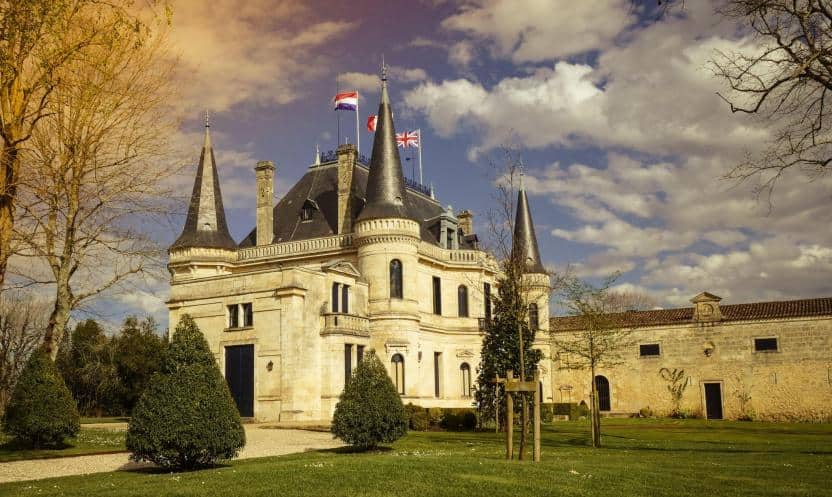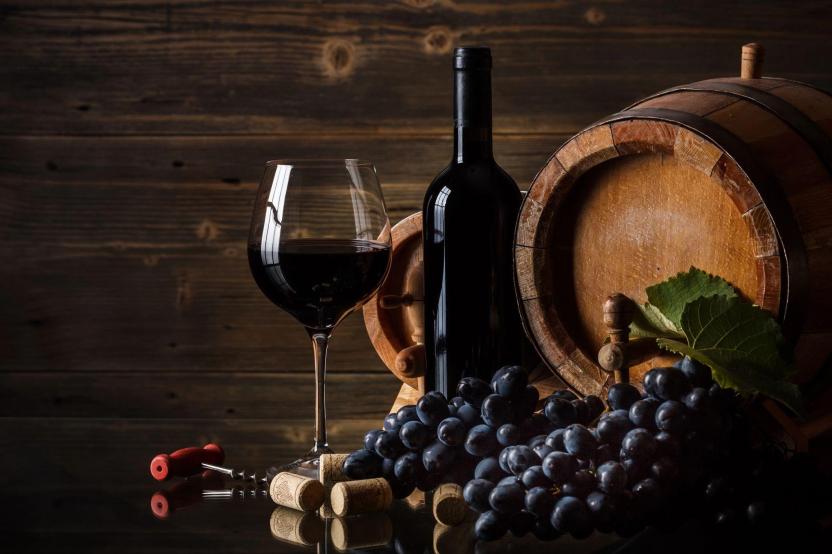Each bottle, each vintage, carries within it the story of its time — of revolutions, rebirths, and quiet moments of triumph.
These wines are more than drinks — they are relics of the past, preserved through the craftsmanship of their creators.
Nowadays, as we increasingly seek connections to history, the appeal of vintage wines has grown beyond their taste.
Barrels, once used to age these remarkable wines, have become prized as remnants of the stories they helped nurture. These barrels, now transformed into furniture, adorn homes, becoming unique pieces of art that allow us to bring a touch of history into our modern lives.
Home wine cellars have evolved into more than mere storage spaces; they are curated corners where the past comes alive, filled with bottles that whisper tales of eras gone by.
The selections that follow are not just about rarity or price; they are about the moments in history they encapsulate.
From French revolutionaries and pioneering Australian winemakers to Tuscan visionaries and Spanish artisans, each vintage tells the story of time and place, its barrels becoming relics that transcend their original purpose.
The wood that once aged these wines now serves as a reminder that, just like wine, history ages beautifully when cared for with passion and respect.
Château Margaux 1787: A Taste of Revolution

In the year 1787, France stood on the cusp of monumental change. The country was embroiled in social unrest, with whispers of revolution growing louder.
Amid this tumultuous backdrop, nestled in the quiet, fertile lands of Bordeaux, Château Margaux continued its centuries-old tradition of producing some of the world’s finest wine.
The estate had already gained a reputation among aristocrats and royalty, but it was around this time that Château Margaux 1787 would leave an indelible mark on history.
In 1787, Thomas Jefferson, a lover of French culture and the U.S. ambassador to France, visited Bordeaux. He meticulously noted his favorite wines, with Château Margaux standing tall among them. Jefferson’s endorsement immortalized the 1787 vintage, not just for its complexity and elegance but for its symbolic connection to a period of intellectual ferment and change.
This was a wine that spoke of the Enlightenment, a time when ideas of freedom, art, and refinement were flourishing. As Jefferson returned to America, he brought bottles of Château Margaux with him — liquid evidence of the beauty and craftsmanship still thriving in a land soon to be ravaged by revolution.
The estate itself is a monument to endurance. While the French Revolution toppled monarchies, Château Margaux stood firm, its wine a testimony to the timeless pursuit of perfection. The barrels that aged the 1787 vintage, crafted from French oak, held not only wine but also the echoes of history — times when kings and philosophers alike sipped from its contents.
Even today, those rare bottles of Château Margaux 1787 tell the story of a world in flux, of Jefferson’s reverence for French viniculture, and of an era defined by elegance amidst revolution.
The very barrels that aged this legendary wine have since become pieces of art, repurposed into furniture that now adorns the homes of collectors, carrying with them the spirit of a time when the old world gave way to the new.
Penfolds Grange 1951: A Visionary Defiance in the Land Down Under
In the aftermath of World War II, Australia was a land of recovery and reinvention. The world was still piecing itself back together, and for many, Australia represented a new frontier — untamed, vast, and filled with potential.
Against this backdrop of resilience and rebuilding, a young winemaker named Max Schubert set out to create something bold and unprecedented in the Australian wine industry.
In 1951, Schubert introduced the first experimental vintage of Penfolds Grange, an audacious blend of Shiraz that defied the norms of Australian winemaking. At the time, Australia was known more for its sweet, fortified wines than for bold reds.
Schubert dared to challenge this convention, inspired by the robust wines of Bordeaux that had captivated the world. Yet, when he first presented his creation to Penfolds’ executives, they were unimpressed. The project was swiftly shut down, and Schubert was told to abandon his dream.
But Schubert didn’t give up. In secret, he continued to produce Penfolds Grange, defying both his superiors and the Australian palate of the time. The 1951 vintage, though produced in small quantities, became a symbol of quiet rebellion — an echo of Australia’s pioneering spirit. Like the country itself, Penfolds Grange was a story of persistence, of vision in the face of doubt.
It took nearly a decade before the wine was rediscovered and hailed as a masterpiece, marking the beginning of Australia’s rise as a serious contender in the world of fine wines.
The barrels that aged this first Grange vintage are relics of that era of innovation and quiet defiance. Today, these oak vessels are more than just historical artifacts—they are symbols of Max Schubert’s unwavering belief in his craft.
The wood from these barrels, once used to age the wine that would change Australian winemaking forever, has found new life in artful furniture, adorning homes with a piece of history.
Every chair, table, or cabinet fashioned from these barrels tells the story of 1950s Australia — a country learning to define itself on the global stage, one bold bottle of wine at a time.
Château d’Yquem 1811: A Sweet Symphony in the Year of the Comet

In the early 19th century, Europe was captivated by the heavens. The great comet of 1811, a celestial spectacle that hung in the night sky for months, was believed to bring fortune, influencing everything from harvests to the course of wars.
For winemakers in the Bordeaux region of France, the comet heralded a vintage of mythical proportions. Château d’Yquem, already celebrated for its luxurious sweet wines, produced a wine in 1811 that would become one of the most storied in history.
The vineyards of Château d’Yquem, located in the esteemed Sauternes region, thrived under the comet’s auspicious glow. The conditions for winemaking were perfect — the balance of sun and mist allowed the noble rot, Botrytis cinerea, to develop, concentrating the sugars and flavors in the grapes.
The 1811 vintage emerged as a golden nectar, rich with notes of honey, apricot, and spice, embodying the opulence of French nobility and refinement.
This wine wasn’t just a product of the earth—it was a symbol of a world at a crossroads. Napoleon was on the rise, and Europe was undergoing seismic political shifts. Yet, within the walls of Château d’Yquem, time seemed to stand still. The wine that flowed from their barrels that year carried with it the promise of timeless beauty.
Over the decades, bottles of Château d’Yquem 1811 became the stuff of legend, with collectors and connoisseurs coveting its near-perfect balance and unmatched aging potential.
The barrels that aged this exquisite wine became artifacts of a golden era. Today, fragments of those oak barrels are often repurposed into elegant furniture, bringing a piece of the 19th century into modern homes.
Bodegas Vega Sicilia Unico 1962: Spain’s Timeless Masterpiece

Spain in the early 1960s was a nation finding its footing. The scars of the Spanish Civil War had begun to heal, and the country was ready to reassert itself on the global stage.
Amid this backdrop, in the Ribera del Duero region, Bodegas Vega Sicilia quietly crafted a wine that would come to define the legacy of Spanish viticulture. The 1962 vintage of Vega Sicilia Unico stands as a testament to patience, precision, and Spain’s ability to produce wines that rival the greats of France and Italy.
Unlike many wines that are rushed to market, Vega Sicilia’s Unico is aged for years, often decades, before it is deemed ready for release. The 1962 vintage underwent an extended maturation process, spending years in both French and American oak barrels before being bottled.
The result was a wine of extraordinary complexity, with layers of dark fruit, tobacco, and spice that unfold slowly, revealing the rich history of the region.
At the time, Spain was emerging from the shadow of its turbulent past, and Vega Sicilia Unico 1962 represented a nation’s ability to create something lasting and profound.
This wine spoke not only of the land and the vineyard but of the country’s renewed sense of pride. It became a symbol of Spain’s resilience and artistry, proving that even in difficult times, beauty could be crafted with care and dedication.
The barrels that aged the 1962 Unico, once saturated with the flavors and aromas of this extraordinary wine, have since taken on new lives. In Spain, where craftsmanship is deeply valued, these barrels are often repurposed into stunning pieces of furniture, from rustic tables to finely detailed cabinets.
Each piece carries with it the history of the wine it once nurtured, offering a tangible connection to a time when Bodegas Vega Sicilia helped put Spain on the global wine map.
Château Lafite Rothschild 1869: A Vintage of Aristocratic Prestige

In the heart of the 19th century, France was at the crossroads of tradition and modernity. The Franco-Prussian War loomed on the horizon, and the old aristocratic ways were slowly giving way to a new order. Yet, in the tranquil vineyards of Bordeaux, Château Lafite Rothschild remained a symbol of timeless elegance.
The 1869 vintage, produced during this period of transformation, would become one of the most revered wines in history, representing not only a mastery of winemaking but also the enduring prestige of French aristocracy.
Château Lafite Rothschild was already a favorite among royalty, with the estate dating back to the 17th century and the wines gracing the tables of kings and emperors. The 1869 vintage, crafted from the gravelly soils of the Médoc, was no exception.
Its bouquet of rich fruit, cedar, and tobacco became a hallmark of Bordeaux’s left bank terroir. But what set it apart was its connection to history — a wine produced in an era when Europe was on the brink of dramatic political change, yet its flavor spoke of permanence and refinement.
The 1869 vintage, while exceptional in taste, became a collector’s dream due to its rarity and association with the Rothschild family, one of Europe’s most influential dynasties.
The wine came to symbolize not just France’s winemaking excellence but the power and grace of an era gone by. In modern times, bottles of Château Lafite Rothschild 1869 have fetched staggering prices at auction, but its story goes beyond mere numbers.
The barrels used to age this extraordinary vintage have become relics in their own right. These oak vessels, which once cradled the wine during its maturation, now serve as the foundation for artisanal furniture, often transformed into stunning tables or decorative pieces.
Each creation carries with it the legacy of Lafite and the 19th century—a time of regal beauty and the unshakable confidence of French winemaking, forever immortalized in the wine that filled those barrels.
Antinori Tignanello 1971: Revolutionizing Italian Wine in the Hills of Tuscany
The early 1970s in Italy was a time of change, marked by social upheaval and cultural innovation. The country’s wine industry, however, was still deeply rooted in tradition, bound by stringent rules that stifled experimentation.
Yet in the sun-drenched hills of Tuscany, one family dared to break the mold. Antinori, whose winemaking history stretched back over 600 years, defied convention with the release of the 1971 Tignanello — a wine that would spark a revolution and put Italy on the world stage for fine winemaking.
At the time, Chianti was the dominant wine in Tuscany, subject to strict regulations that mandated the use of certain grape varieties. But the Antinori family, led by Piero Antinori, wanted more. With the 1971 vintage, they introduced a blend that included Cabernet Sauvignon and Cabernet Franc, grapes not traditionally allowed under Chianti rules.
Tignanello was born, a rebellious “Super Tuscan” that would forever change the course of Italian winemaking.
The 1971 Tignanello was rich, bold, and full of complexity, challenging the notion that Italian wines had to conform to outdated traditions. It quickly gained international acclaim, opening the door for a new generation of winemakers to experiment with non-native varieties and modern techniques.
Tignanello became a symbol of Italian ingenuity and creativity, proving that innovation could exist alongside centuries-old heritage.
The barrels used to age this groundbreaking wine are imbued with the spirit of Tuscany’s rolling hills and sun-soaked vineyards.
Today, some of these barrels have been repurposed into beautiful furniture, with their oak staves reimagined into wine racks, tables, or even bespoke cabinetry. Each piece crafted from the wood that once held Tignanello tells a story of defiance, artistry, and the bold vision of the Antinori family, whose commitment to pushing boundaries brought Italian wine into a new era.
Romanée-Conti 1945: The Last Wine of a Vanishing Vineyard

The year 1945 was a pivotal one for Europe, a time when the world emerged from the shadows of World War II, seeking hope and renewal. In the small, revered region of Burgundy, France, one of the most legendary wines in the world was quietly being born — the Romanée-Conti 1945.
This vintage would not only mark the end of an era but would become one of the most sought-after and valuable wines in history.
Romanée-Conti, situated in the Côte de Nuits, is known for its small production and exceptional quality. The vineyard is often described as sacred ground for winemaking, with only a tiny plot of land yielding what many consider the finest Pinot Noir on Earth.
But the 1945 vintage was especially significant — it was the last year the vineyard’s pre-phylloxera vines, over 100 years old, would produce grapes before being uprooted and replanted. And the 1945 Romanée-Conti carries with it the final expression of vines that had survived both the phylloxera epidemic and the devastation of war.
The wine produced that year was extraordinary — deep, complex, and possessing an almost ethereal quality. The war had left much of France in ruins, but Romanée-Conti emerged from the chaos, creating a wine that symbolized endurance and resilience.
Only 600 bottles of this vintage were made, and they soon became the stuff of legend. Each bottle told the story of a vineyard that had weathered the storms of history, from the Napoleonic Wars to World War II, and still managed to produce something of unimaginable beauty.
The story of Romanée-Conti 1945 is not just about wine; it’s about survival and the indomitable spirit of Burgundy’s winemakers.
After the vines were pulled up, the land was replanted, but the 1945 vintage remains irreplaceable — a moment in time, forever captured in those precious bottles.
Today, the barrels that held this rare wine are revered as relics of winemaking history. On occasion, they have been transformed into bespoke furniture pieces, cherished by collectors and connoisseurs alike.
The oak that once cradled the final fruit of Romanée-Conti’s ancient vines now lives on in artful creations — tables, chairs, and other fine furnishings that tell the story of a vineyard’s resilience and a wine that defied the odds.
The Final Sip as a Toast to Time and Legacy
as we pour the final glass from these rare vintages, it is impossible not to feel a connection to those who came before. Those who, despite the chaos of their time, persevered, believing that something as simple as a grape could transcend all else and tell a story that would outlive them.
It is a bittersweet reminder that, like wine, our lives are fleeting, yet they have the power to leave behind a legacy that can endure.
The barrels that held these wines, once kissed by the earth and fire, now find themselves reborn and repurposed into pieces of our lives, our homes. They sit in our living rooms as tables or chairs, silent but powerful, reminding us that history is not just something we read about but something we live with, touch, and feel.
These fragments of oak carry the weight of centuries, of hands that once harvested grapes in times of war, peace, and revolution.
Here’s to time, to wine, to all the moments we carry with us — and to the ones that will carry us forward long after our final sip.
